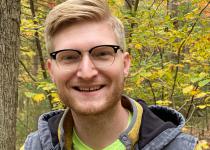
Contact
I am a botany curator and plant ecologist studying the functional ecology of understory plant species in temperate forests, especially in the context of climate change and introduced species invasions. As a museum curator, I strive to facilitate and broaden the use of natural history collections by students, researchers, and the public. As a museum-based researcher, I use herbarium specimens, field experiments, and observational data to understand basic plant function and complex ecological interactions. My research program explores a diverse range of topics under the umbrella of global change biology and museum collections. These projects currently focus on the following:
1) New roles for natural history collections in the Anthropocene. With over 390 million plant specimens collected by thousands of botanists over nearly five centuries residing in over 3,000 collections worldwide, herbaria (collections of preserved plant specimens) comprise an enormous resource for understanding the world around us. Herbarium specimens are receiving unprecedented attention due to recently developed methods, new perspectives, and perhaps most notably, their increased accessibility through widespread digitization. While the longstanding functions of herbaria rooted in taxonomy and systematics remain critically relevant in modern research, herbarium data are increasingly used in unanticipated ways. A major aim of my research seeks ways to increase the research value of museum specimens, enhancing traditional uses and developing new uses altogether. We are involved in several large-scale specimen digitization projects. We are rethinking the way new specimens are collected, in addition to how existing specimens are used in research. My research program uses specimens as spatially, temporally, and taxonomically rich sources of phenotypic and genotypic data. More specifically, we are using specimens to uncover human-induced shifts in leaf functional traits, plant flowering times, and even plant root-associated microbial communities.
2) Phenological mismatch and impacts of disrupted interactions under climate change and species invasions. The seasonal timing of biological events such as leaf emergence, flowering, and fruiting is especially critical for forest wildflowers that rely upon high light in the spring, before being shaded out by trees. Our research in the northeastern United States demonstrates that the timing of leaf out for overstory trees advanced at a faster rate than understory wildflowers in response to warmer spring temperatures over the past 150+ years. This climate change-induced phenological mismatch between overstory trees and understory wildflowers has already significantly decreased understory wildflower plant carbon budgets and is projected to cause further performance declines in the coming decades. In addition to climate change, our forests are increasingly invaded by non-native shrubs with extended leaf phenology (early leaf out in spring and/or late leaf drop in autumn), forming dense canopies that further reduce understory light levels. We are studying the impacts of increased shade on forest wildflowers, the biological mechanisms explaining different phenological responses of trees, shrubs, and wildflowers, and how these phenological mismatches may differ across latitude and different temperate forest floras of the world.
3) Physiological ecology of native and invasive plants. The globalization of human activities has resulted in the movement of plants around the world, with ecological impacts of serious conservation concern. This ongoing reshuffling of species serves as one of the largest unplanned experiments in ecology and evolution. Intuitively, it appears paradoxical that non-native species, with no opportunity for local adaptation, can exhibit greater fitness than native plants with this advantage. Our research seeks to explain what traits or strategies make invasive species successful, and whether invaders follow different physiological tradeoffs than native species. The success of native and invasive plants in eastern North American forests intersects with other aspects of environmental and ecological change, including novel species interactions, deer overabundance, climate change, and habitat degradation. Our research focuses on several invasive species of concern in the Pittsburgh area and beyond, especially in forests, including allelopathic garlic mustard (Alliaria petiolata) and Japanese, giant, and hybrid knotweed species (Reynoutria spp.). While much of these comparative ecophysiological studies are couched in terms of biological invasions and conservation, at the core of my research is understanding why plants from different regions of the world might function differently, despite similar present-day abiotic conditions. Current theories on the evolution of plant function assume strong global convergence in resource use strategies, yet many invasive species seem to follow different physiological tradeoffs than native species.
Perez, T.M., Rodriguez, J. & Heberling, J.M
Heberling, J.M. (2020) Museum specimens are mor
Reeb, R.A., Acevedo, I., Heberling, J.M., Isaac, B
Pearson, K.D., Nelson, G., Aronson, M., Bonnet, P.
Shouman, S., Mason, N.W.H., Heberling, J.M, Kichey
Hedrick, B. P., Heberling, J. M., Meineke, E., Tur
Kattge, J., Bönisch, G., Díaz, S., Lavorel, S., Pr
Heberling, J.M., Prather L.A. & Tonsor, S.J. (2019
Heberling, J.M., Burke, D.J. (2019) Utilizing herb
Heberling, J.M., McDonough Mackenzie, C., Fridley,
Heberling, J.M., Cassidy, S., Fridley, J.D. & Kali
Heberling, J.M. & Isaac, B.L. (2018) iNaturalist a
Heberling, J.M. & Mason, N.W.H. (2018) Are endemic
Shouman, S., Mason, N.W.H., Kichey, T., Heberling,
Heberling, J.M. & Isaac, B.L. (2017) Herbarium spe
Wavrek, M., Heberling, J.M, Fei S. & Kalisz, S. (2
Heberling, J.M., Brouwer, N.L. & Kalisz, S. (2017)
Heberling, J.M., Jo, I., Kozhevnikov, A., Lee, H.
Heberling, J.M. & Fridley, J.D. (2016) Invaders do
Heberling, J.M., Kichey, T., Decocq, G. & Fridley,
Heberling, J.M. & Fridley, J.D. (2013) Resource-us
Heberling, J.M. & Fridley, J.D. (2012) Biogeograph
Siefert, A., Ravenscroft, C., Althoff, D., Alvarez
Russo, L., Stehouwer, R., Heberling, J.M. & Shea,
Zhang R., Heberling, J.M., Haner, E. & Shea, K. (2
Dr. Heberling received his Ph.D. in 2015 with Jason Fridley at Syracuse University, performed his postdoctoral studies with Susan Kalisz at the University of Tennessee and Stephen Tonsor at the Carnegie Museum of Natural History. He joined the department as an adjunct faculty member in 2020.
